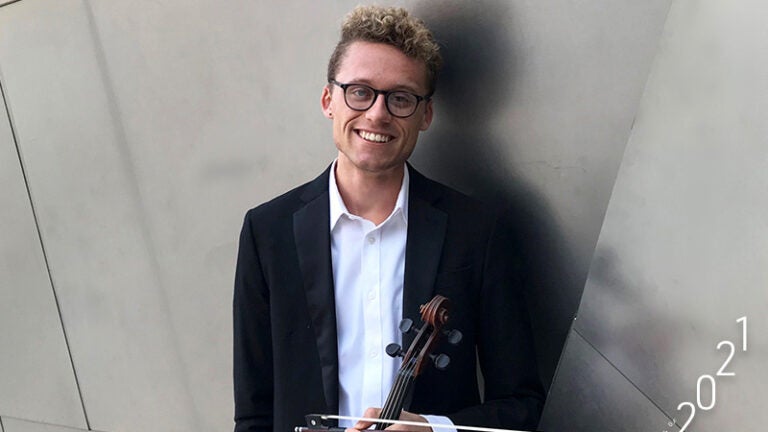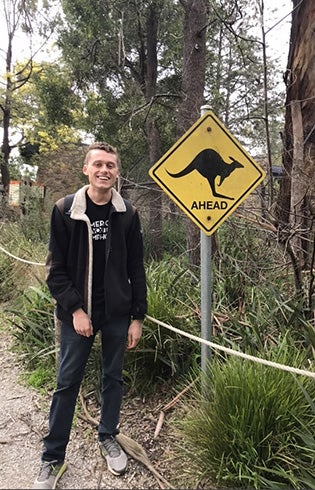
Love for nature and music come together for graduating USC Dornsife senior
To Cameron Audras, viola is the instrument that sounds most human. “The viola has this rich, dark tonality. It’s really close to the range of the human voice,” he says.
If Audras’ viola could speak, it would probably say something urgent about climate change. Audras, who is graduating with a degree in environmental studies from the USC Dornsife College of Letters, Arts and Sciences and degree in music from the USC Thornton School of Music, often uses his instrument to express his concern for the environment.
At his recent senior recital, he played “Sonata for viola and piano: Leaving Earth” by Stuart Greenbaum, which envisages a soundtrack for humanity departing the planet after it has become uninhabitable. Behind Audras glowed NASA’s famed Earthrise photo.
“I performed this piece and talked about how Earth seems so indestructible in your everyday surroundings but, when you see it in this image, it just looks so fragile,” he says.
This fall, he heads to the University of California, Santa Barbara to obtain a master’s degree in environmental science management. He’ll also continue viola lessons at the university. Audras credits his time at USC with teaching him how to interweave both his love of the viola and his interest in environmental conservation.
Pave paradise and put up a parking lot
Audras’ first passion was music. He’s played piano since the age of five, but a riveting violin bluegrass performance in elementary school made a big impression.
“I didn’t even know violins could do that; I thought it was all just Beethoven,” he says.
He started violin lessons but in middle school was asked to switch to the viola because the school’s orchestra had too many violinists. Audras is glad he agreed.

NASA’s famous Earthrise photo, taken from the surface of the moon, inspired the Earth Day movement. (Photo: NASA/Bill Anders.)
“Viola ended up opening so many opportunities I wouldn’t have had on violin,” he says. “Violas are always in demand.”
Audras’ also felt drawn to nature. He grew up in the Los Angeles suburb of Agoura Hills and spent his childhood exploring the foothills and meadows beneath the Santa Monica mountains. Strip malls and suburban sprawl were changing this idyllic greenspace, however. Audras watched as grassy fields became shopping malls and tract housing.
“Those might have been some of my earliest [environmental] reckoning moments,” says Audras. “Seeing these landscapes being overtaken by development.”
His two interests first collided when he attended a music camp on the edge of the Sequoia National Forest. “We played outdoors in the forest, under these gorgeous redwood trees, and I think it brought it all home for me. I was like, ‘This is it — this is where I want to be,’” says Audras.
When applying to universities, Audras knew he didn’t want to sacrifice one interest to focus entirely on another. He found a balance at USC. “I could pursue both and it was celebrated,” says Audras.
Cameron down under
During his junior year, Audras took a formative trip abroad to Australia through the USC Dornsife Overseas Studies program. He enrolled in classes at both the University of Melbourne and at the Melbourne Conservatorium of Music. A backpacking excursion in Tasmania with an environmental club, led by indigenous elder Stephen True-Arrow, was particularly eye-opening.
“He talked about the mother rock that was close to where his ancestral tribe was based,” says Audras. “The way they perceive place is so different than a western world view. I realized we weren’t hearing these voices and they’re the ones most impacted by climate change.”
Back at USC, Audras got the chance to listen to community voices through research conducted with Jennifer Bernstein, lecturer at USC Dornsife’s Spatial Sciences Institute. Audras collected information on attitudes towards solar energy installations in the Mojave Desert, then placed these reactions on an interactive map to gauge what areas were favorable for placement.
“I’ve found that people’s sentiments are much more complex than your average ‘Not-In-My-Back-Yard,’” says Audras.

Audras studied abroad in Australia thanks to a USC Dornsife Overseas Studies program. (Photo: Hao Xiong.)
Understanding where people prefer solar panels could help prevent objections from residents and make solar construction go more smoothly. Audras and Bernstein are currently working on a paper they plan to submit to academic journals.
“Cameron proved himself to be a complex thinker, able to combine disciplines and methodologies to deeply explore environmental issues,” says Bernstein. “His positive attitude and active approach to problem-solving made him a joy to work with.”
Playing for change
Through Bernstein, Audras was introduced to Robert Vos, associate professor (teaching) of spatial sciences. A cellist in Orange County’s Pacific Symphony, Vos is also passionate about the environment and focuses his research on industrial ecology.
For Audras, Vos was an excellent role model. Audras recently received a grant from the USC Arts and Climate Collective to produce “The Resilience Project,” a series of performance pieces that explore solutions to climate change through dance, music and spoken word.
“[Vos] has been my inspiration throughout all of this. I hadn’t felt like I could even do anything like this before meeting him,” says Audras.
When he’s not immersed in his studies or the viola, Audras takes binoculars and camera out for birding adventures, a hobby he’s developed over the COVID-19 shutdown.
“I got an amazing shot of a crane with its wings fully spread out,” says Audras. It’s an activity that provides a visceral reminder for why he’s made protecting the Earth a personal priority.